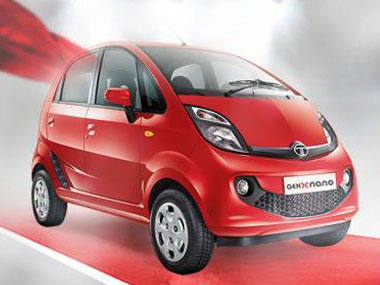After several false starts, the Tata Motors management may finally have got its act together with the Nano’s re-re-re-relaunch. Unveiling today (19 May) is the automatic version of the car, the GenX Nano, priced in the range of Rs 1.99. lakh and Rs 3 lakh for multiple variants .
Unlike the first version of the Nano, which was developed based on a Ratan Tata hunch that people may upgrade from “unsafe” two-wheelers to “safe” cars if only the pricing was right, this time the company is launching 21 variants of GenX after detailed consumer studies and feedback, reports The Economic Times.
It had better work this time, for Tata cannot afford another flop show. The “Rs 1 lakh car” has more than $1 billion of investments riding on it. If it does not shine this time, the Nano will be more or less history.
The Nano’s primary problem has always been its perception. Even before it was launched, it was dubbed the “Rs 1 lakh car” based on a Ratan Tata interview in which he talked about such a pricing. The glib assumption that pricing alone would do the trick turned out to be wrong. The consumer wondered if she was getting a glorified autorickshaw or a poor quality four-wheeler for that kind of money. Lower price was seen as implying lower quality – an impression fanned by news reports about the odd early Nano or two catching fire, which the company’s PR handled poorly. Perception thus became reality in consumer minds.
In its first relaunch, the management goofed again. It focused on affordability, and offered EMIs that matched those for two-wheelers. This reinforced the “cheap” perception and also that this may not be quite a real car, especially in a market where second-hand cars were available in plenty at comparable prices.
The second relaunch, which involved a few minor design tweaks and quality improvements and the creation of a new Nano sub-brand – the Twist - fared a little better, but fundamental impressions did not change. By the time Twist arrived on the scene, most manufacturers had dished out their own cheaper cars –from the Chevrolet Beat to the Hyundai Eon to the Maruti Alto 800.
Now, things seem to be different. At the upper end of the Tata GenX pricing, it is only around Rs 50,000 cheaper than the base Alto 800, which has an on-road price in Mumbai of around Rs 3.5 lakh, including insurance and registration.
While a saving of Rs 50k is nothing to sniff at, clearly this time the Tata Nano is not using price alone as its selling point. It is selling a real car, with the right consumer benefits. It is, according to Girish Wagh, senior Vice-President at Tata Motors, being repositioned in the small hatchback compact car segment.
The ET report says the “GenX Nano is better looking, has a stronger body, and improved fit and finish with key functional features like a small boot, power steering, automatic transmission and fully loaded Bluetooth connectivity.”
We should wait for consumer feedback to check if the new positioning and changes work, but there is little doubt that the Tata Motors bosses have learnt the right lessons from past failures. They are no longer trying to sell a replacement for two-wheelers or a “cheap car”, even though the Nano will indeed attract upgrades from the two-wheeler segment.
It will probably be sold as a Smart City car, which is not a bad position to take for an automatic, since crowded city streets make manual gears tiresome in bumper-to-bumper traffic situations. Also, given its smaller engine, even the fuel-efficiency loss due to the use of automatic transmission will not be a negative for the new Nano. Indian consumers are sensitive to fuel consumption averages, and automatic transmission cars have not taken off for this reason.
The fact that the GenX Nano now comes with 21 variants is interesting. Last year, I had talked about the key changes I would like to see in the Tata Nano if consumers will take a relook at it. These were:
#1: A comfortable and spacier two-seater city car which has some boot space too - and foldable rear seats that can make way for more boot space. (It is not clear if a two-seater is an option with GenX).
#2: A car with big changes in the outward design. The current design is not sexy enough, and the young, who might be potential buyers, would not buy it. College-goers now using bikes may, conceivably, buy a car that looked like the VW Beetle, even if it performed like a - well - Nano. (Some changes have been made to the looks, and they are worthwhile).
#3: An automatic transmission by default - which will target women and senior citizens. Honda scooters is the preferred choice of all those who don’t want to be kicking bikes into action. No reason why cars have to be more complicated. The Maruti-Suzuki Celerio is an effort to rope in new car users. The Nano should target the same. (The new Nano has addressed this market)
#4: An electric car priced at a max of Rs 3.5-4 lakh, and which can be charged easily from home power sockets. (This may come later)
#5: A rural Nano version, with a bench-like front seating (where one kid can be accommodated on the lap of the second traveler), and an open carrier (like a micro-truck) at the back to carry goods or more kids. Rural families travel on the backs of mini-trucks like this only (This may still happen.)
#6: A price tag in the range of Rs 2 lakh (on-road) and going upto Rs 3 lakh (which is the current range anyway) (The new pricing is more or less there).
#7: Tubeless tyres as the default option to make the car hassle free on punctures. (This might be an option on GenX)
#8: A diesel version for rural areas; for city areas, mileage is not an issue, since it is meant to be a short-distance car. (This should be coming soon.)
#9: Instant payment options by credit cards; instant EMI options (without elaborate paperwork) like the way smartphones are sold - automatic conversion of loans to EMIs. (It’s a matter of deals with banks.)
#10: A name change. The name Nano was a good one in 2008; today it has the looks of a loser. It is not easy to reposition a loser with cosmetic changes and an old name. A new name will help Tata Motors reinvent the platform (GenX is a sub-brand on the Nano platform. It just may work, but the jury will be out till consumer feedback becomes positive).
My gut feel is the new Nano GenX is a potential winner. The Tatas will be hoping I am right.


)




)
)
)
)
)
)
)
)